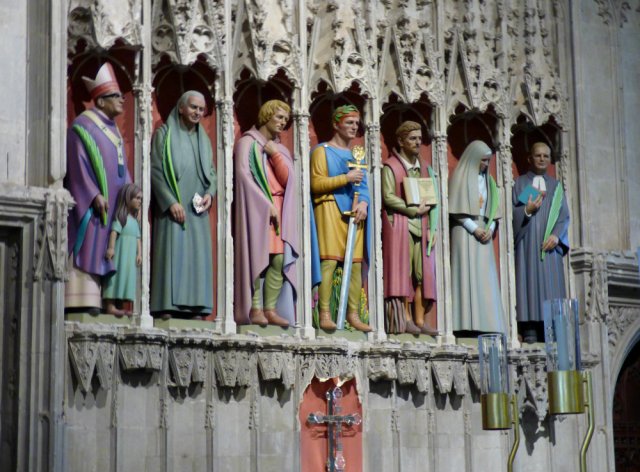The fifth post on our visit to the Abbey of St Albans a few years ago. Parts One, Two, Three and Four can be found by clicking the highlighted links.

In the Anglican year, our visit still fell within the season of the Nativity and the figures depicting the birth of Jesus still stood before the altar in the nave. The brightly coloured statues on the altar screen seemed incongrous somehow, even though such colour would have covered the walls long ago.
The stone rood screen was built by Abbot Thomas de la Mare, around the time of the Black Death (1349-51) to divide the lay side of the Abbey from the monastic. It was richly carved, filled with statues and surmounted by the Rood, or Cross. At either side of the screen, two doors were built through which the monks could process, bearing the relics of St Alban. These two doors remain, both flanked by a series of portraits of the Green Man.
The statues and carvings were destroyed during the Reformation, when Henry VIII broke with Rome and was declared head of the Church of England in 1534. For centuries the niches stood empty.
The freshly coloured statues that now stand there are a very recent commission by the Abbey from sculptor Rory Young. They depict seven martyrs, each carrying the martyr’s symbol of the palm branch, executed for their faith, from St Amphibalus and St Alban himself to some very recent figures. The Dean of the Cathedral writes that there are “martyrs in every age – probably more now than there have been for many years – and inspire us to be braver ourselves in standing up for what we believe.” A sentiment that, in our time, where division and prejudice are still rife, may apply to each one of us, regardless of our faith … as long as it is applied with compassion and understanding for the beliefs of others.
There is a vast difference between affirming what we personally believe to be true and seeking to impose that belief on others… just as there is a huge gulf between sharing our beliefs in a spirit of understanding and coexistence and seeking to bully and blast people, both individuals and nations, into submissive compliance with the bigotry of the few.
I can’t say I particularly liked these statues… they may need a few hundred years to mellow before they are aesthetically pleasing. Nor do I like the fact that such deaths still occur. But they are beautifully executed… and I cannot help but agree with the message they are sending of the need for tolerant and peaceful coexistence.

Oscar Romero – Roman Catholic Archbishop of El Salvador, under a totalitarian regime, he condemned poverty, social injustice and torture until his assassination during Mass in 1980.
St Alban Roe – a Roman Catholic, imprisoned for a time in St Albans Abbey Gatehouse and hanged in London in 1642 having been found guilty of treason for being a Roman Catholic priest.
St Amphibalus – a Christian priest sheltered by Alban, when Christianity was forbidden.
St Alban – The first British saint, beheaded in Roman Verulamium on the site of the Abbey in the third century AD.
George Tankerfield – burnt to death in Romeland, an alley close by, in 1555 because, as a Protestant, he refused the doctrine of transubstantiation.
St Elisabeth Romanova – a granddaughter of Queen Victoria. Married into the Russian Royal Family, she embraced the Orthodox Church, becoming a nun and Abbess after her husband died. She was murdered in 1918 by the Bolsheviks.
Dietrich Bonhoeffer – Lutheran pastor and theologian, sent to a Nazi concentration camp, tried with neither witness nor defence, he was hung in April 1945.









































The screen of the martyrs is disturbing, only because it is still happening. I remember the killing of Oscar Romero in 1980.
LikeLike
We do tend to think of martyrdom as something that ended centuries ago, yet many still suffer and die for their faiths. It was a bold move to put such a modern centrepiece to the screen and one that should hold some meaning for all of us, no matter what our beliefs may be. All of us should have a right to a personal faith or belief.
LikeLike
There is something about the newness of the martyr statues which really brings home how this is not something which only happened centuries ago – and despite the passage of time since the first martyr humans have learnt little about respect, love and tolerance.
LikeLike
I felt the same way about the screen, Mary. It sits oddly amongst the older stone, but really highlights the fact that this is still part of an ongoing story that we have yet to reslove.
LikeLiked by 1 person
That is wonderful. Also once new saints to be seen as sculptures. The statues in color are also an eye-catcher. Thank you for sharing this wonderful insight, Sue! Best wishes, Michael
LikeLike
When you see some of the older churches where the mediaeval wall paintings still survive intact, you begin to realise how important colour once was in our churches.
LikeLike